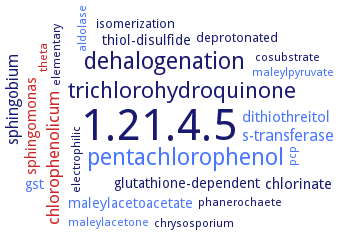1.21.4.5: tetrachlorohydroquinone reductive dehalogenase
This is an abbreviated version!
For detailed information about tetrachlorohydroquinone reductive dehalogenase, go to the full flat file.

Word Map on EC 1.21.4.5 
-
1.21.4.5
-
pentachlorophenol
-
dehalogenation
-
trichlorohydroquinone
-
chlorophenolicum
-
s-transferase
-
sphingobium
-
dithiothreitol
-
chlorinate
-
sphingomonas
-
gst
-
maleylacetoacetate
-
thiol-disulfide
-
glutathione-dependent
-
isomerization
-
deprotonated
-
maleylacetone
-
maleylpyruvate
-
electrophilic
-
cosubstrate
-
elementary
-
pcp
-
chrysosporium
-
aldolase
-
theta
-
phanerochaete
- 1.21.4.5
- pentachlorophenol
-
dehalogenation
-
trichlorohydroquinone
- chlorophenolicum
- s-transferase
-
sphingobium
- dithiothreitol
-
chlorinate
- sphingomonas
- gst
- maleylacetoacetate
-
thiol-disulfide
-
glutathione-dependent
-
isomerization
-
deprotonated
- maleylacetone
- maleylpyruvate
-
electrophilic
-
cosubstrate
-
elementary
- pcp
-
chrysosporium
- aldolase
- theta
-
phanerochaete
Reaction
Synonyms
PCP hydroxylase, pcpC, TCHQ dehalogenase, tetrachloro-p-hydroquinone reductive dehalogenase, tetrachlorohydroquinone dehalogenase, tetrachlorohydroquinone reductive dehalogenase
ECTree
Advanced search results
Engineering
Engineering on EC 1.21.4.5 - tetrachlorohydroquinone reductive dehalogenase
Please wait a moment until all data is loaded. This message will disappear when all data is loaded.
C13S
C156S
experiments are carried out using C156S TCHQ dehalogenase, which has only one Cys residue at position 13 in the active site, in order to avoid complications in the synthesis of ESSG arising from reactions with Cys156, which is located on the surface at a distance from the active site. The substitution of Ser for Cys at position 156 does not appear to affect any properties of the enzyme
C14A
the mutant enzyme displays greater than 25fold decreased activity relative to the wild-type enzyme. The pH optimum decreases from 50°C for the wild-type enzyme to 44°C for mutant enzyme S12A
S12A
the mutant enzyme displays greater than 25fold decreased activity relative to the wild-type enzyme, the mutant enzyme shows an increase in the molar ellipticity between 260 and 280 nm, relative to the wild-type enzyme. The pH optimum decreases from 50°C for the wild-type enzyme to 44°C for mutant enzyme S12A
S15A
the mutant enzyme displays greater than 25fold decreased activity relative to the wild-type enzyme. The pH optimum decreases from 50°C for the wild-type enzyme to 40°C for mutant enzyme S12A
Y7F
activity of the mutant enzyme is not significantly different from the wild-type enzyme
Y9F
activity of the mutant enzyme is not significantly different from the wild-type enzyme
the mutant converts tetrachlorohydroquinone to 2,3,5-trichloro-6-S-glutathionylhydroquinone and an unidentified isomer of dichloro-S-glutathionylhydroquinone rather than to dichlorohydroquinone
C13S
the mutant enzyme catalyzes only the initial steps in the reaction. In the absence of Cys13, the intermediate 3,5-dichloro-6-S-glutathionyl-4-hydroxycyclohexa-2,4-dienone decomposes to a mixture of products in a pH-dependent fashion
C13S
the mutant enzyme shows no affinity for the glutathione-Sepharose affinity matrix. The mutant enzyme is not inhibited by 2,3,6-trichlorohydroquinone
C13S
the mutant enzyme, which catalyzes the reaction only to the point at which Cys13 is required. The reaction proceeds by a rapid equilibrium random sequential kinetic mechanism. Substrate analogues that lack a second hydroxyl group cannot be turned over to products, although they can bind to the active site. The rate of the reaction is strongly influenced by the number of electron withdrawing substituents on the substrate. These findings are consistent with a mechanism that begins with ketonization of the deprotonated substrate to form 2,3,5,6-tetrachloro-4-hydroxycyclohexa-2,4-dienone, followed by 1,4-elimination of HCl to from trichlorobenzoquinone. Subsequently, trichlorobenzoquinone is attacked by glutathione to form a glutathione conjugate that, in the absence of Cys13, decomposes to a mixture of products, either at the active site or after release into solution


 results (
results ( results (
results ( top
top






